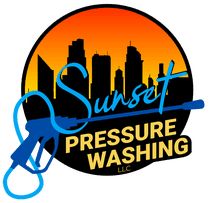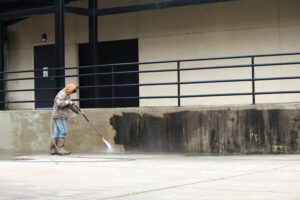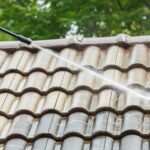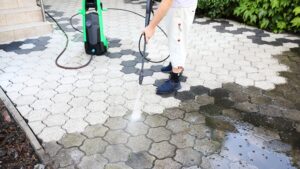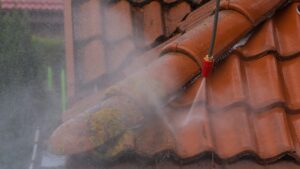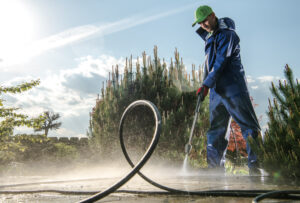
Avoiding Common Pitfalls in Pressure Washing: A How-To Guide
We've put together this guide to help you prepare for your first time using a pressure washer. Here, you'll discover the most common pressure washing mistakes and how to avoid them.
It’s no surprise that more people are starting to understand the benefits of pressure washing, and the market is growing around 3-4% yearly. But pressure washers are powerful machines. And if you haven’t used one before, you run the risk of making some costly pressure washing mistakes.
1. Not Testing the Pressure Washing Equipment Using the Wrong Setting
If you haven’t used a pressure washer on a particular building before, you must do a test wash before you start.
Your first step is to test the pressure washer kit. Inspect the equipment, check it’s all there, and ensure it’s in working order and correctly assembled (use the instructions if you’re unfamiliar with it).
Choose a low-risk test area for your first wash. It’s useful to do this on the part of a commercial building that’s not so visible to the public. When carrying out a test run, your main priority is to check that you’re washing at the correct pressure.
This vital step will ensure that you don’t cause surface damage to the building when you do the complete wash. It will also allow you to make sure you’re using the equipment safely and correctly.
2. Using the Wrong Setting
The average pressure washer will come with several different settings, though it will vary depending on the make. But you’ll have settings to change the flow rate and amount of pressure, and you may find it comes with different nozzle attachments.
However, using an incorrect setting on a wash could cause problems.
You could either end up in a situation where you haven’t washed the building thoroughly or mistakingly use a high-pressure setting that causes damage to the external walls of a building.
Always read the manual before you start work, as this will guide you on the correct settings. And make sure you’re using the correct nozzle for a particular setting – the instruction manual should explain these.
3. Using the Wrong Detergent is a common pressure washing mistake
You must use the correct type of detergent and cleaning chemicals in a pressure washer.
Detergent brands specifically formulated for pressure washers will give you a better finish. You will find that they are more effective at removing dirt, grime, and stains and won’t leave the building with a visible residue.
You should check the manufacturer’s instructions to find the right cleaning solution. Make a note of the type of surface you’re cleaning. For example, stone walls will need a different cleaning solution than wood.
You should also research eco-friendly solutions. Harsh chemicals could damage older buildings as well as the environment. A more natural solution is a better all-around and, if working with customer buildings, maybe something they request.
4. Not Finishing With a Rinse
A professional pressure wash will always include a detergent. So you must finish a wash with one last water rinse. This final step will help remove any remaining dirt and, most importantly, will wash off the cleaning solution and residue.
A rinse also helps protect the building, as some chemical cleaners could damage wall material if left in place for too long. It could corrode metal or stain walls, for example.
A rinse also helps you get that sparkling finish.
To run a rinse wash, you may need to change the settings and nozzles on your pressure washer. So always check the manufacturer’s guidelines before you start.
When rinsing, always use cold water, as warm or hot water may react with any remaining cleaning residue.
5. Operating the Washer Too Close
Always follow the manufacturer’s guidelines when standing the correct distance from a building wall. If you operate a pressure washer too close to the surface you’re cleaning, you may run into problems.
Firstly, operating a pressure washer too close could pose a danger to you, as you may loosen weak material in the wall and trigger falling debris.
And in the long term, putting too much pressure on a wall could damage the appearance and, in the worst-case scenario, the structural integrity of the building. You could also force water into gaps that may rot or mold.
Fortunately, you can observe warning signs that you’re too close and prevent the problem from worsening.
Look for splats, marks on the wall, or signs of paint wearing or chipping away. Most importantly, look for signs that water accumulates around the front of the wall you’re washing.
6. Not Maintaining the Washer
A pressure washer will only effectively work if it’s in good working order. So regular maintenance is essential. It will help ensure all components work as they should and help prevent severe and costly breakages.
Basic maintenance tasks will include checking the pump, ensuring it’s well lubricated, and inspecting the hoses to ensure they are clean. You may find it better to hire a professional to do more thorough maintenance checks on a pressure washer.
You should aim to run a basic maintenance check on a pressure washer each time you use it. For more formal inspections, book an annual service.
7. Ignoring Safety
Safety is paramount when operating a pressure washer. You need to keep yourself and the general public safe and ensure the safety of the building.
Always wear appropriate safety clothing when operating a pressure washer. That includes goggles and gloves. Protective, long sleeve waterproof clothing is also a good idea.
Cordon off the area to ensure pedestrians and workers don’t walk in front of the building when you’re operating the machinery.
Check the safety instructions on the machine before you start, and also run a small test first to ensure you aren’t damaging the building.
Lastly, always inspect electrical items before you start work.
Contact the facilities manager for the building to make them aware of your cleaning routine and ask them to switch off any equipment, electrics, and lighting in advance.
Avoid These Pressure Washing Mistakes
You may feel tempted to get going with a pressure washer once you have one to hand. But always prepare the job first to avoid pressure washing mistakes that could damage you, the machine, or the building.
Alternatively, hire a professional with the experience to do the job perfectly for you.
